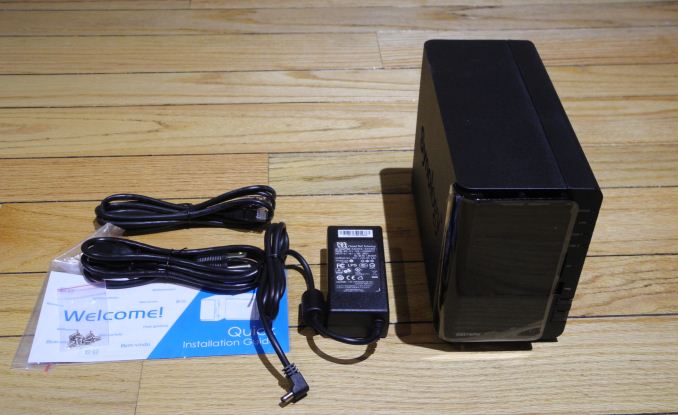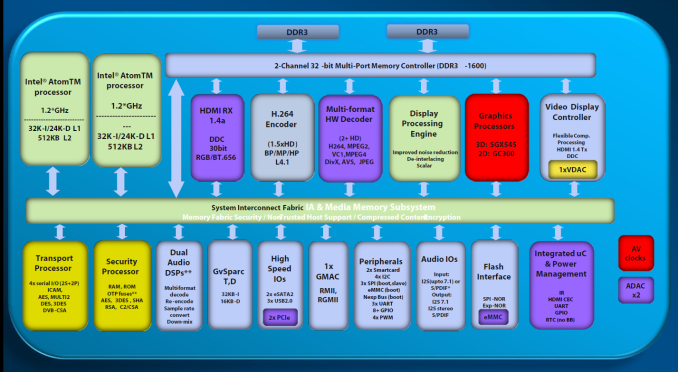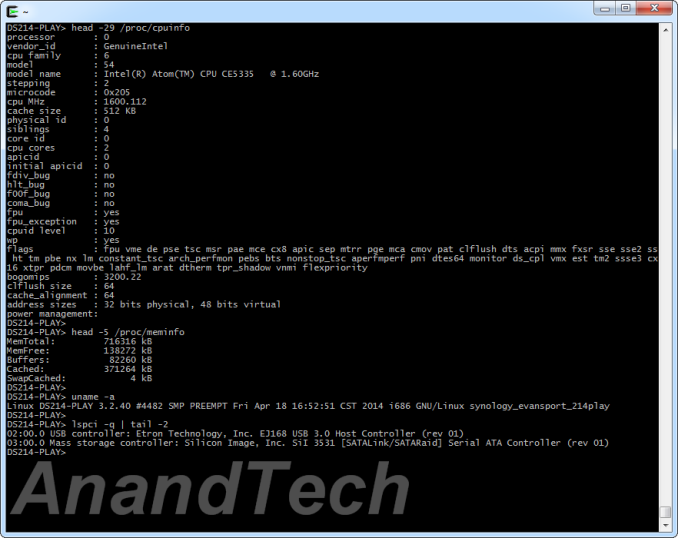Synology DS214play: Intel Evansport Almost Done Right
by Ganesh T S on May 20, 2014 3:00 PM ESTHardware Aspects & Usage Impressions
The industrial design of Synology's 2-bay NAS units hasn't really changed since we last reviewed one in the DS211+. We continue to have the detachable face-plate (a fingerprint magnet) and hot-swap bays (with the hard drives kept in place on the caddies with screws on the side). The contents of the DS214play package are as below:
- Synology DS214play chassis
- 2M Cat 5E Ethernet cable
- 65 W external power supply with US power cord
- Getting Started guide
- Screws for hard disk installation
In terms of external I/O, we have a SD card slot and a USB 2.0 port in the front panel. On the rear, we have two USB 3.0 slots, an eSATA port and a single RJ-45 GbE port. The eSATA port can be used to attach a DX513 5-bay expansion module to provide a total of 7 bays. An important aspect to remember is that the hard drives in the expansion module can't be used for volume expansion, but additional volumes only.
Platform Analysis
The block diagram below gives the layout of the Intel CE5335 SoC. Typically, x86 NAS units come with dual network ports (capable of port trunking), but units based on Evansport (such as the DS214play) don't have that because of the lack of support in the platform. This is acceptable, considering that the unit is supposed to cater to home consumers who want to use it as a media server.
The other important aspect is the available high-speed I/Os. In a NAS platform based on the CE5335, there are two SATA ports and two PCIe 2.0 lanes. There is no native USB 3.0 support in the SoC. Therefore, the DS214play's USB 3.0 support definitely from a USB 3.0 to PCIe bridge. Since the two SATA ports are already being used for the drive bays, it can be inferred that the eSATA port is enabled using a PCIe to SATA bridge. Considering these inferences, it looks like the platform should be able to support all peripherals at full speed (except for the two USB 3.0 ports which talk to the SoC through a single PCIe lane). One option to determine the components on the board would have been disassembling the unit. Fortunately, Synology provides SSH access. The screenshot below exposes some of the hardware aspects of the DS214play.
As expected, the USB 3.0 ports are enabled by the Etron EJ168A USB 3.0 to PCIe bridge, while the eSATA port is enabled by the Silicon Image SiI 3531 SATA to PCIe bridge. TechPowerUp also has a great teardown of the NAS in their review, where they show these components on the board (in addition to the Realtek RTL8211E GMAC for the GbE port and the Genesys Logic GL836 SDIO to USB 2.0 bridge for the SD card slot). A look back at the CE5335 block diagram shows that we have three USB 2.0 ports in the SoC. Only two get used, one for the SD card slot and the other for the front USB 2.0 port.
Setup & Usage
After connection to the network, the unit obtains a DHCP address (even in diskless mode) and could be setup using the web UI at http://<DS214play-IP>. The setup process is straightforward. At least one of the bays needs to be populated. We chose to use the Synology Assistant tool to initialize the NAS (we have used the web interface before in our previous Synology reviews). The firmware (Synology Disk Station Manager - DSM) can be uploaded from a local file in this process. Basic network settings (DHCP / manual static IP) can also be set up using the tool. After a restart, the rest of the configuration is handled through the web interface.
Upon logging into a freshly installed DSM, the user is provided with various options to aid in setup of external access to the NAS. Synology allows its users to create a MyDS account on their servers. The NAS units themselves are provided with a unique 'QuickConnect' ID. A MyDS account can have multiple QuickConnect IDs associated with it. The combination of this ID and a MyDS account helps Synology operate a relay service for access to the NAS from an external network. Users can opt to not register for these, but still enjoy external access if they forward the appropriate ports on their router. We will cover more on this in a later section.
DSM 5.x, in keeping up with the previous versions, is undoubtedly the gold standard to which all other NAS interfaces must measure up to. The combination of a desktop-style interface and a multi-tasking UI with support for desktop widgets make it a pleasure to use. Backing up the eye-candy is a rock-solid Linux-based storage management system and a wealth of applications (both Synology-created and third-party developed). Exploring all the features of DSM 5.x deserves a separate piece by itself. However, we will take a slightly different approach. In one of the later sections, we will look in detail into the external access and multimedia features of DSM 5.x (an area where the DS214play is supposed to excel). We have some more Synology reviews in the pipeline and those will be used to look at the other features.
Our testing sequence started with the insertion of a single disk and configuring it in Synology Hybrid RAID (SHR). For a single disk, it is effectively a JBOD configuration, but the addition of a second disk triggers a migration to RAID-1. While migrating to the new RAID level on the DS214play, the data remained online (as expected) and the process got done without any hitch. We tested RAID-1 rebuild by yanking out a disk during operation and re-inserting it. The rebuild process was also uneventful. On the whole, we were very satisfied with the unit's handling of storage operations (including handling of disk failures).





































45 Comments
View All Comments
Lundmark - Wednesday, May 21, 2014 - link
Plex does work on the ds214play! I use it all the time on mine. Just download the latest package from the Plex website and upload manually.It doesn't support hardware transcoding however, and it probably never will (on evansport).
Be Careful - Friday, May 30, 2014 - link
Hey what do you know about İntel?Please read and learn.
http://www.jimstonefreelance.com/corevpro.html
ScooterComputer - Tuesday, June 3, 2014 - link
One place that I also found it interesting that Synology didn't employ the transcoding feature of the SoC was with Surveillance Station, even in the latest SS6.3 Beta. The number of cameras and features the DS214play supported (requiring transcoding) was below what I'd expect compared to even the DS214. [http://www.synology.com/en-us/products/compare_pro...]Fallout552 - Monday, June 16, 2014 - link
How would hooking one of these up to the router and then (best case conditions in theory) streaming via powerline to an HTPC for transcoding work? Would a DS214se work just as well since the transcoding is taking place on the HTPC, not the NAS?raymondub - Saturday, September 20, 2014 - link
Hii was thinking to buy the Synology DS-214+ or DS214Play and to use it with the raspberry Pi to watch movies on TV. I d like to watch also movies on 2 different samsung galaxy tab 2 through DS Video . So which is the best ? DS-214+ or DS214Play ?
thx